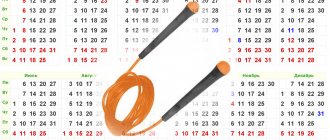How to measure basal temperature correctly
The basic rules that must be followed when measuring basal temperature include the following points:
- Of course, you can start measuring your temperature on any day, but it’s still better to start doing this with the onset of the first day of your menstrual cycle.
- The temperature must be measured in one place: vaginally, rectally, orally. You need to choose one of these methods since measuring the temperature under the armpit will not give an accurate result. Throughout the entire cycle, it is very important not to change the location of the temperature change.
- If you choose the oral method, then you need to place a thermometer under your tongue and measure the temperature for five minutes, while you need to completely close your mouth. If you choose the rectal or vaginal method, then the temperature measurement time can be reduced to three minutes.
- The temperature must be measured in the morning, before you get out of bed. In this case, you should sleep at least six hours for a more accurate result.
- The temperature must be measured at the same time, but if the deviation in time exceeds 30 minutes, then this result cannot be considered correct. This temperature will not be taken into account in the chart.
- You can use any thermometer of your choice to measure your basal temperature, but you should not change it throughout your cycle.
- If you choose a mercury thermometer, then knock it down immediately after measuring or before going to bed, as if you put effort into it in the morning, this can significantly affect the result obtained.
- Basal temperature can be affected by stress, anxiety, taking medications, long flights, and so on.
BT is determined immediately after waking up after several hours of rest, without getting out of bed or making sudden movements.
You should have a mercury thermometer on hand so that you can easily reach it. An electronic thermometer does not give such accurate indicators, and drawing a graph requires accuracy. Temperature measurements are taken every day at the same time of day for several months. Basal temperature is measured orally, rectally or vaginally. Measuring temperature through the anus is most preferable, as it provides more reliable information. BT is always measured in the same way in order to be able to build an accurate graph.
Before measuring basal body temperature, you must stop drinking alcohol and avoid overwork and stress. Insomnia, hormonal medications, colds, fatigue, sexual intercourse several hours before measuring BT - all this can affect basal body temperature. With such factors, there will be no temperature peaks on the graph, since hormones give equal readings throughout the entire cycle.
How to measure basal temperature?
This is body temperature, which illustrates changes in the internal genital organs under the influence of certain hormones. The indicator indicates the presence and timing of ovulation and shows whether the ovaries produce progesterone, a hormone that prepares the inner walls of the uterus for a possible pregnancy.
Why should you know your basal temperature?
First of all, this allows us to solve a number of problems:
- Find out how correctly the ovaries produce hormones throughout the menstrual cycle.
- Determine the time of egg maturation. This is necessary in order to identify “dangerous” and “safe” days for the purpose of contraception or planning conception. See which contraceptive methods are not reliable.
- Determine whether pregnancy has occurred due to a delay or unusual periods.
- Identify the possible presence of endometritis - inflammation of the uterus.
Measurement Rules
You should take your temperature every morning at the same time as soon as you wake up. Moreover, any physical activity is excluded, even conversation. It is better to prepare a thermometer for measurement in the evening, after shaking it off and placing it by the bed. A mercury thermometer measures 5-6 minutes, an electronic thermometer takes 50-60 seconds.
There are 3 ways to measure:
- Oral. You need to put the thermometer under your tongue and close your lips.
- Vaginal. The thermometer is inserted into the vagina without lubricants half its length.
- Rectal. The thermometer is inserted into the anus using lubricants.
The mercury thermometer should be removed from the top without grasping it. You should not remove it while holding onto the location of the mercury, as this may cause an error in the measurements.
You should also remember that:
- It is best to start measuring on the first day of the cycle, after 5-6 hours of sleep.
- Measurements should be carried out only in one of the ways.
- Measurements are not taken during the use of oral contraceptives, hormonal drugs and alcohol.
What should the temperature be at different periods of the cycle?
The basal temperature in the first phase of the cycle during normal ovulation should be 37ºС, before ovulation it decreases, and during ovulation and in the second phase it rises by 0.4 ºС, on average.
The highest probability of conception appears 2-3 days before the increase in indicators, and on the first day of ovulation.
If the elevated temperature persists for more than 18 days, this may be a sign of pregnancy..
In the absence of ovulation, the basal temperature fluctuates between 36.5 ºС – 36.9 ºС throughout the entire cycle.
During pregnancy
- If pregnancy proceeds correctly , then the readings rise to 37.1 ºС - 37.3 ºС, and they remain at this level for four months.
- Low readings at 12-14 weeks may indicate a possible threat of miscarriage.
- If the temperature rises to 37.8 ºС , then this indicates inflammatory processes inside the body.
- Prolonged maintenance of indicators at 38 ºС and above can cause serious damage to the health of the unborn child. Therefore, if the indicator rises to this level, you should immediately consult a doctor.
What do you know or want to ask about basal temperature?
This informational article does not constitute medical or diagnostic advice. At the first sign of disease, consult a doctor. Don't self-medicate!
How to build a BT chart?
This is not difficult at all, you need to do the following:
- Take a sheet of paper in a cage,
- Draw the X and Y axis,
- Horizontal - days of the menstrual cycle,
- Vertical – temperature readings.
- or use our online service and build your own basal temperature chart - convenient, understandable, practical
The thermometer is held in the anus for an average of about 5 minutes. Mark a temperature point on the graph every day. Then all the points are connected by a line. The doctor will have a more accurate idea of the processes occurring in the female reproductive system if he builds a graph over several monthly cycles, at least three.
Basal temperature chart
Drawing up a basal temperature chart itself is actually not that difficult. For the graph you will need an ordinary checkered piece of paper, which is drawn out manually: horizontal and vertical rays are drawn from one point. The days of the menstrual cycle are marked on the horizontal beam, and degrees are recorded on the vertical beam, with the calculation of 1 cell = 0.1 degrees. Every morning, when measuring your basal temperature, you should immediately make a corresponding note in the chart, marking the indicators with a dot.
For maximum reliability, it is better to draw up a schedule for no less than 3 cycles. And then you can study the dynamics of the curve by determining the day of ovulation.
BT and the menstrual cycle
To measure BT, strict adherence to time is required; it is advisable to measure it at the same hour, and even during menstruation.
On “these days” temperature indicators are purely individual. There are, of course, average temperatures, we will take them as the norm: the normal temperature during menstruation is 37.0, and at the end it drops to approximately 36.4. This is due to changes in hormonal levels. In the middle of the menstrual cycle, before the upcoming ovulation, the temperature on average ranges from 36.4 to 36.6 degrees. As soon as a mature egg is released from the ovary, the basal temperature rises by half a degree. Such a jump in the graph will indicate that ovulation has occurred.
The other half of the cycle is characterized by a slight rise in temperature, to about 37.2 degrees. Before menstruation there is a decline (up to 0.3), this indicates the approach of critical days.
Decoding basal temperature readings
Basal temperature readings vary throughout the menstrual cycle and are individual for each woman.
That is why it is impossible to say exactly what the values should be on a given day of the cycle for all women.
Below we consider the most common indicators of basal temperature in a healthy woman:
- basal temperature in the mouth during menstruation. During this period, normal indicators are at the level of 37-37.9 ºС. As a rule, on the 1st day of the cycle the values are still elevated (37.9 ºС), and in subsequent days they drop to approximately 37.1-36.3 ºС.
- basal temperature in the mouth on days 5-7 of the cycle. In the 1st phase of the menstrual cycle, the duration of which can be from 5-6 days until ovulation, basal temperature values are normally reduced and do not exceed 36.8 ºС.
- basal temperature in the mouth during ovulation. Immediately before ovulation (1 day), basal temperature values decrease, then the values increase noticeably to 38.5 ºС. This indicates the beginning of ovulation.
- basal temperature in the mouth after completion of ovulation. After ovulation, basal temperature values remain high and are above 37 ºС. In this phase of the cycle, temperature fluctuations may be observed by no more than 0.1-0.3 ºС; this is the norm. High basal temperatures are observed before the onset of menstruation, and then gradually decrease.
- basal temperature in the mouth during pregnancy. In early pregnancy, basal temperature readings are exceeded (more than 37.7 ºС). If menstruation does not occur on time, and the temperature does not exceed 37 ºС, then, most likely, conception has not occurred.
- basal temperature in the mouth while taking oral contraceptives. When taking contraceptives, basal temperature values directly depend on the pills themselves. Throughout the month, a woman takes oral contraceptives daily, so the hormones in her blood are at approximately the same level throughout the menstrual cycle. This means that basal temperature indicators remain the same. There may be some temperature fluctuations, but there are no peaks characteristic of the ovulation period.
Rules for measuring basal temperature
If your goal when constructing a BBT chart is to determine the exact date of conception, then you need to learn how to analyze the chart.
If the temperature does not decrease before the upcoming menstruation, this may indicate pregnancy. For some women, the graphs do not show rises and jumps in temperature at all - this most likely indicates that there is no ovulation, and infertility can be assumed. If during a missed period the temperature is far from normal and is low, then most likely a miscarriage occurred before the missed period. If the temperature increases during menstruation, this indicates inflammatory processes in the female genital area.
Every woman who cares about women's health should know how to measure basal body temperature. This simple procedure, of course, requires a little effort and a little time, but you will always have accurate data about the functioning of your reproductive system.
What is basal temperature?
Basal temperature is the body temperature at rest for at least 5-6 hours. Usually, its measurements are carried out in the morning. It is at this time that the body is in a relaxed and rested state.
For a woman, the basal temperature curve changes under the influence of various hormonal surges, and its peak comes on the days of ovulation. Using this data, a woman can determine the best day for conception (ovulation), find out the exact days of menstruation, determine the safest days for sex, and even see women's problems.
Quite often, gynecologists resort to basal temperature when they need to find out:
- how many days are left until ovulation;
- does the patient have it?
- trace the hormonal background of a woman;
- identify the reasons why you cannot get pregnant and identify the causes of infertility;
- this temperature is used to diagnose early pregnancy;
- there is a strong claim that it can even help conceive a child of a certain gender. But this fact is not scientifically confirmed.
To do this, representatives of this beautiful part of the planet must keep a basal temperature chart. This is a fairly simple method. BT is measured every day and marked on the graph.
According to the basal temperature graph, you can see the dynamics of hormonal changes in the body.
Usually, the BT chart needs to be maintained several cycles in order to more accurately see the picture of what is happening.
Basal temperature norms
Measuring and recording the temperature is only half the battle. To understand these numbers and graphs, you need to know what a standard graph should look like, and based on this, draw conclusions about the state of your body.
In medicine, there are five types of temperature curve. The very first type is characteristic of a normal cycle. The remaining four indicate a deficiency of one or another hormone.
Provided that a woman’s body works without deviations, the basal temperature during menstruation will be in the range of 36.4-36.7 degrees. After they end, shortly before ovulation, it drops sharply to 36.3-36.2. Then the indicator grows rapidly and within a day rises to 36.6-36.7.
After ovulation, it remains at 37 degrees for another 10 days. And before menstruation, it drops again to 36.6.
When taking oral contraceptives, BT will be approximately the same throughout the entire cycle.
This is what a normal curve should look like
If the graph shows strong deviations from the norm, you should definitely see a doctor, but only if the woman is sure that she did everything correctly and the BT measurements were carried out without violations.
Interpretation of results and possible causes of deviations from the norm
During the newborn period, a basal temperature of 37.5 - 38 C is considered normal, while body temperature values recorded in the armpit range from 36.3 to 37.2 C.
A sudden rise in temperature followed by a decrease cannot be regarded as a symptom of the disease. This may be due to the baby being overexcited, overtired, or staying in a hot room for a long time. If the child is active, alert, eats normally and gains weight, but the basal temperature stubbornly remains at 38 C, then it is advisable to contact a pediatrician to exclude hidden inflammatory processes. At the same time, if the temperature exceeds 38.5 C, the child is restless, refuses to eat and is capricious, then this indicates that the baby is infected.
Why is basal temperature measured?
The process of measuring temperature is very painstaking, so many women wonder why they need to spend a lot of time on this activity.
In fact, the information obtained can be useful in many cases:
- When you need to find out the exact date of ovulation.
- As one of the ways to diagnose the functioning of the ovaries.
- In order to calculate the days that are safe for sex.
- Suspect the onset of gynecological diseases.
- Find out when your period starts.
- Find out whether pregnancy occurred during a delay.
Most often, the BBT measurement method is used as a home ovulation test. But you need to fully rely on this method only if the woman does not have any menstrual cycle pathologies .









